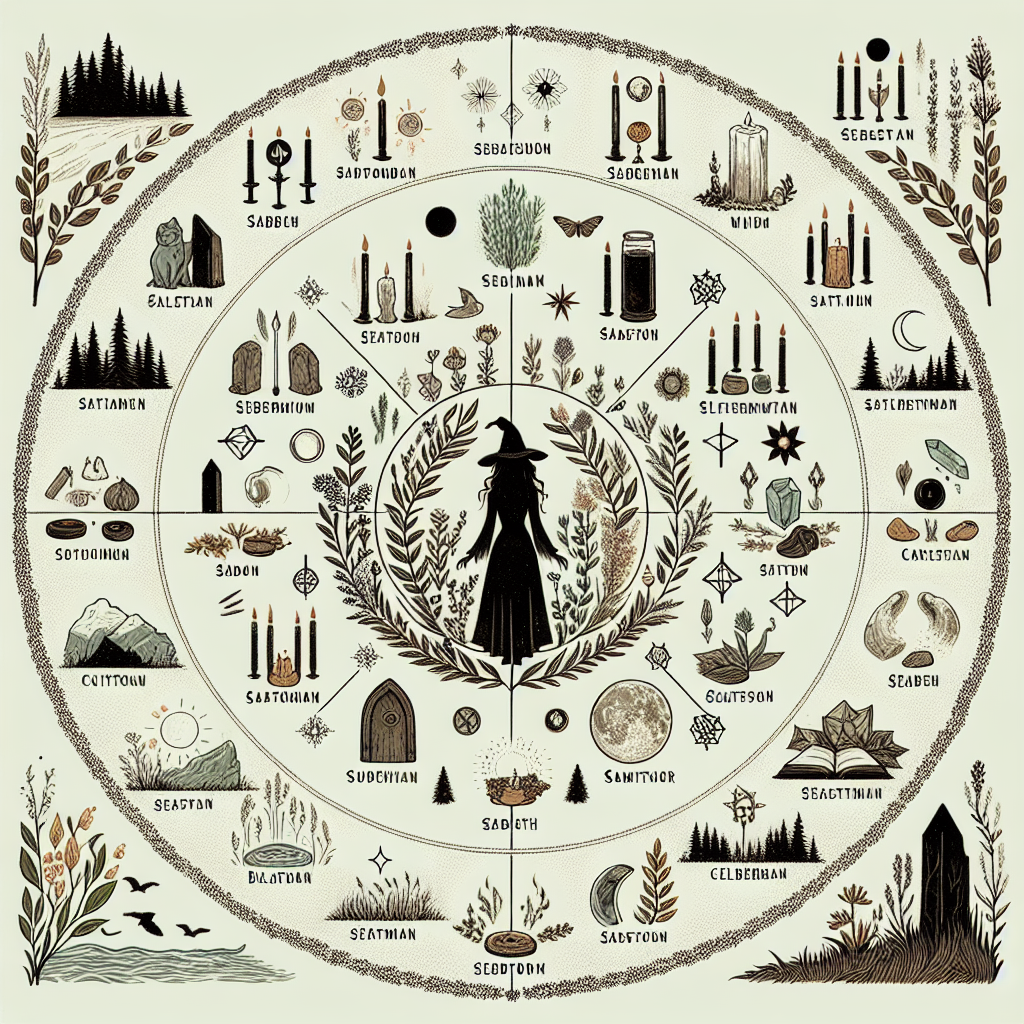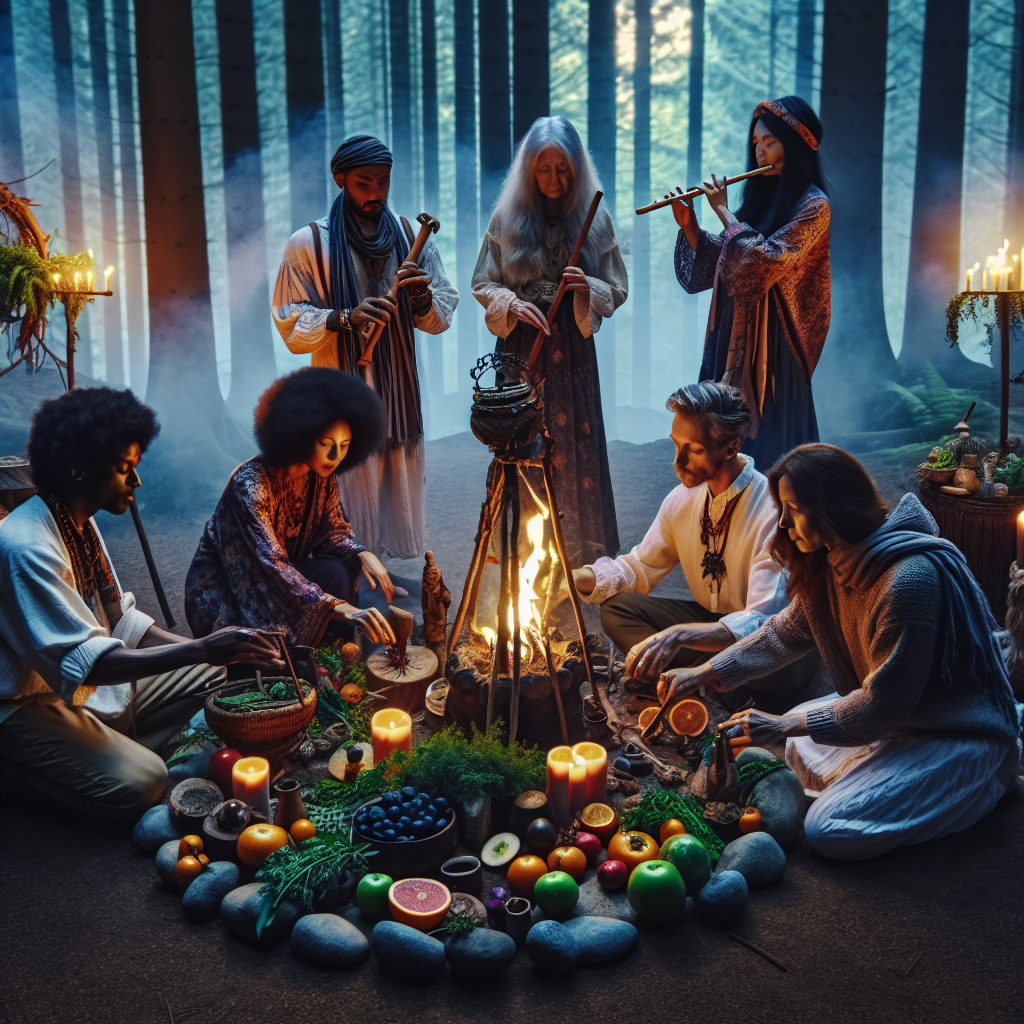As an Amazon Associate I earn from qualifying purchases.
↻
Last updated: December 24, 2025

The Wheel of the Year is an annual cycle of seasonal festivals observed by many modern pagans, with eight major sabbats that are widely celebrated. However, there are also solitary witches who follow an expanded version of the Wheel of the Year, recognizing 24 minor sabbats, or “Lesser Sabbats,” which are evenly spaced between the major ones. These celebrations are rooted in ancient agricultural cycles and pagan festivals, adapted over time to fit the practices of individual witches.
These 24 Seasonal Sabbat Celebrations reflect the nuances of the changing seasons and are a testament to the intimate connection solitary witches feel with nature. Historically, sabbats originated in a variety of ancient European pagan festivals, which varied according to local customs and agricultural timelines. Over time, as pagan traditions evolved and spread, different paths of witchcraft began to establish more uniform cycles of celebration, leading to the standard eight sabbats. Some solitary practitioners, seeking a deeper resonance with the Earth's rhythms, have adapted this cycle further, creating a sabbat for nearly every two weeks, each with its own unique energies and themes.
One compelling statistic related to these observances is that they often align with subtle shifts in the environment that many people, even those not following pagan beliefs, notice and respond to. For instance, certain birds might migrate, or specific flowers bloom at these times. Solitary witches pay close attention to these natural occurrences, which guide them in their personal rituals and practices. By observing 24 sabbats, they attune themselves even more closely to these shifts, becoming deeply synchronized with the Earth's natural cycles.
Solitary witches observe these sabbats in various ways that can be both highly personal and creatively fulfilling. Celebrations may include crafting seasonal altars, performing rituals, meditating, and focusing on personal growth that corresponds with the themes of the particular sabbat. There is often a strong emphasis on self-reliance and personal interpretation, as solitary practitioners do not have the structure of a coven. This allows them the freedom to integrate their unique traditions, heritage, and personal experiences into each celebration.
The lesser sabbats along with the eight traditional ones form a spiritual tapestry that provides a constantly evolving framework for the solitary witch’s journey. As each individual witch may have different preferences, these celebrations can also serve as a relatable solution for witches seeking a more immersive and frequent practice, without the need to conform to group dynamics. The solitary path allows for an intimate and flexible spiritual experience that is very much in tune with one's personal rhythms and life changes.
24 Seasonal Sabbat Celebrations for the Solitary Witch
Sabbat celebrations are a cornerstone of the Wiccan Wheel of the Year, which follows the cycle of the Earth's seasons. These pagan holidays honor the natural world, its changes, and the goddesses and gods of the ancient world. For the solitary witch, crafting a personal connection with each Sabbat can imbue life with a rhythmic spirituality that aligns with the ebb and flow of nature. Here we explore 24 Sabbat rituals and activities that can be done alone, celebrating each festival with a unique perspective.
**Yule (Winter Solstice)** – The longest night of the year calls for quiet reflection, candle magic, and honoring the sun's return. Creating a Yule altar with evergreens, berries, and lights and meditating on the rebirth of the light is an ideal way to mark this time.
**Imbolc (February 1st)** – Often associated with the goddess Brigid, Imbolc is a time to celebrate the first stirrings of Spring. Crafting a Brigid's cross, spring cleaning, and candlelight ceremonies can help focus energies on growth and purification.
**Ostara (Spring Equinox)** – As day and night balance, so too should the solitary practitioner. Planting seeds (literally and metaphorically), blessing them for growth, and taking walks in nature to observe the blossoming world are all apt observances for Ostara.
**Beltane (May 1st)** – This fire festival is about fertility, passion, and celebration. Solitary witches might create a small Maypole, light a bonfire, and indulge in the arts, such as painting or writing, to tap into Beltane's creative energies.
**Litha (Summer Solstice)** – A powerful time to celebrate the full strength of the sun. Solitary rituals might include sun salutations, making sun water, or charging crystals and herbs in the abundant daylight.
**Lammas or Lughnasadh (August 1st)** – The first harvest festival, a time to be thankful for physical and spiritual bounties. Baking bread, crafting corn dollies or grain mother figures, and performing gratitude rituals are ways to honor this time.
**Mabon (Autumn Equinox)** – As light and dark come to balance again, Mabon is about thanksgiving and preparation. Harvesting herbs, making wine or preserves, and setting up a feast for one to honor the Earth’s abundance fit the bill.
**Samhain (October 31st)** – Samhain is a profound spiritual time to honor ancestors and the dead. Carving pumpkins, creating an ancestor altar, and performing a silent supper where an extra plate is set for the spirits can all form part of a solitary witch’s practice.
**Repeat the Cycle** – Since there are eight traditional Sabbats, the solitary witch repeats these celebrations throughout the year, alternating between personal and universal interpretations to keep each Sabbat fresh and meaningful.
Additional Sabbat Celebrations:
Beyond the eight major Sabbats, some traditions, including solitary practitioners, may choose to mark other days throughout the year that align with personal beliefs or specific magical workings, leading to potentially 24 or more unique sabbat celebrations.
– **Esbat Full Moon Rituals** – On each of the 12-13 full moons of the year, a solitary witch might conduct a ritual to align with the moon's energies, focusing on intuition, dreams, and psychic abilities.
– **Dark Moon Reflection** – Opposite the full moon, the dark or new moon can be a time for banishing rituals, setting intentions for the new lunar cycle, and deeper self-reflection.
– **Days of Elemental Balance** – Solitary witches may choose to honor the balance of the elements (Earth, Air, Fire, Water, and Spirit) at various times throughout the year, creating mini-observances to deepen their connection to each element's essence.
– **Personal Power Days** – These are days that resonate with the witch’s personal energy, such as birthdays, anniversaries of significant events, or days that hold unique astrological significance based on one's natal chart.
By acknowledging and celebrating these natural cycles, solitary witches form a deep connection with the rhythms of the earth and cosmos, enriching their spiritual practice. The flexibility of solitary practice allows for a diverse and personalized calendar of Sabbat celebrations.
One could imagine a statistical analysis of pagan practitioners revealing that a substantial percentage of solitary witches find increased happiness and a sense of fulfillment by engaging in personalized Sabbat and esbat celebrations, illustrating the profound impact that aligning one's life with natural cycles can have on an individual’s spiritual and emotional well-being.
- What are the 8 main Sabbats that are celebrated by witches?
The 8 main Sabbats in the Wheel of the Year are Imbolc, Ostara, Beltane, Litha, Lughnasadh, Mabon, Samhain, and Yule. These celebrations mark important seasonal and agricultural points throughout the year.
- Can I celebrate the Sabbats as a solitary practitioner, or do I need to be part of a coven?
Absolutely, you can celebrate the Sabbats as a solitary witch. Each Sabbat can be tailored to your personal practice and doesn't require group participation unless you prefer it.
- How can I celebrate the Sabbats if I live in an urban environment with little access to nature?
You can celebrate by creating an altar with seasonal items, lighting candles, meditating, or performing rituals that resonate with the essence of the Sabbat. Use symbols of nature, like leaves, stones, or water, to connect with the season.
- Are there any particular foods or dishes that are traditionally eaten during Sabbat celebrations?
Yes, each Sabbat has traditional foods associated with it, often based on seasonal availability. For example, during Samhain, apples and pumpkins are common, while Yule often features nuts, berries, and spiced dishes.
- Is there a specific way to set up an altar for Sabbat celebrations?
Altar setups can vary widely, but typically include representations of the elements, seasonally appropriate decorations, and symbols of the particular Sabbat you are celebrating. Trust your intuition and creativity.
- How can I tailor Sabbat celebrations to reflect my personal beliefs and traditions?
You can incorporate personal symbols, adapt rituals to reflect your spiritual path, and create your own traditions that align with the core meanings of the Sabbats. The practice should feel meaningful to you.
- What if I can't celebrate a Sabbat on its exact date?
It is entirely acceptable to celebrate a Sabbat on a date close to the actual holiday. Your intention is the most important aspect of the celebration.
- Are there any specific colors or symbols that are important to include in Sabbat celebrations?
Yes, each Sabbat has associated colors and symbols. For example, Imbolc may include white and green for purity and growth, while Beltane might feature reds and florals for fertility and fire.
- Can Sabbat celebrations include spells or magical work?
Sabbats are excellent times for performing spells and magical work, particularly those aligned with the season's energy, such as abundance during Lughnasadh or gratitude during Mabon.
- Do I need to follow a specific tradition or pantheon to celebrate the Sabbats?
No, while Sabbats are rooted in specific pagan traditions, they are flexible and can be adapted to suit any path or pantheon that holds personal significance for you.

Conclusion
Throughout the wheel of the year, the twenty-four seasonal Sabbat celebrations provide solitary witches with a rich tapestry of rituals and observances that link them directly with the cycles of nature. Each Sabbat is a waypoint on this spiritual journey, offering a moment to reflect, give thanks, and align with natural energies. From the introspection and renewal of Yule to the fertile harvests of Lammas, these celebrations foster a deep connection with the Earth and its ever-changing seasons. By adopting personal traditions within each Sabbat, solitary practitioners nurture a profound bond with the elements, deities, and spirit world, tailoring rituals to their unique practice, ensuring meaningful and transformative experiences throughout the year.
Key insights include the importance of understanding the symbolism and underlying meaning of each Sabbat, as well as the versatility to adapt and influence one's spiritual practice in solitude. Harvesting herbs, crafting talismans, or simply meditating during these powerful times can bring about personal growth and wisdom. Integrating these Sabbat celebrations into daily life not only honors the ancestral roots of witchcraft but also empowers the solitary witch to live a life that is in harmonious rhythm with the natural order. Embracing the Sabbats is about finding balance and joy in the cycle of life, death, and rebirth—and the solitary witch's path is made all the richer for this observance.
Amazon and the Amazon logo are trademarks of Amazon.com, Inc, or its affiliates.
Continue Your Magical Journey
Free Witchcraft Starter Kit
Get 6 free printable PDFs: grimoire pages, moon calendar, spells, crystals, herbs, and tarot journal.
We respect your privacy. Unsubscribe anytime.
Enhance Your Practice
As an Amazon Associate, I earn from qualifying purchases.

